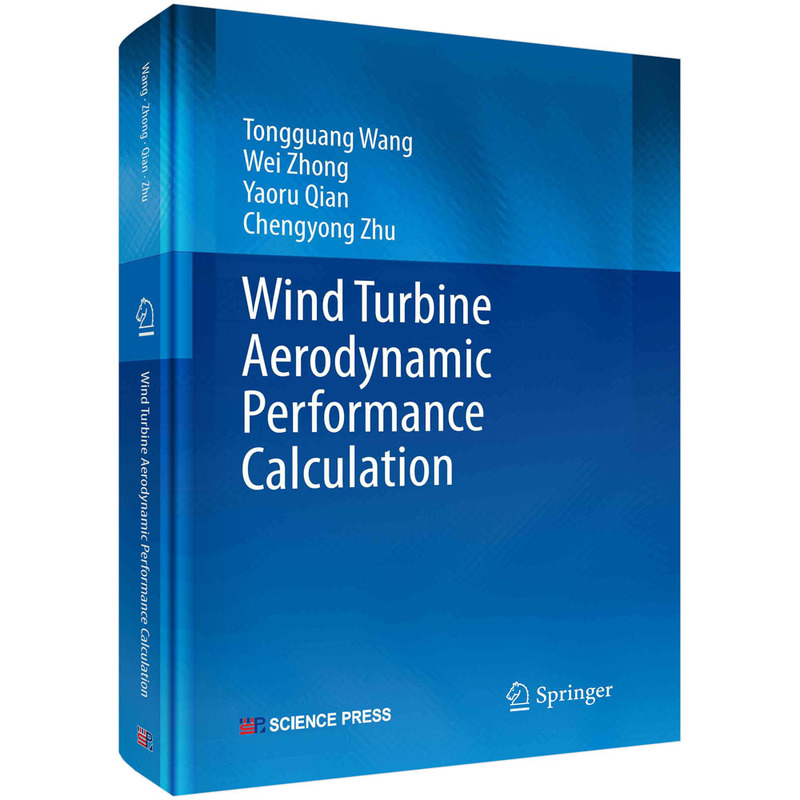暂无评论
图文详情
- ISBN:9787030777720
- 装帧:精装
- 册数:暂无
- 重量:暂无
- 开本:B5
- 页数:242
- 出版时间:2024-01-01
- 条形码:9787030777720 ; 978-7-03-077772-0
内容简介
本书全面介绍风力机气动性能计算的主流方法,兼顾学术性与工程实用性。首先介绍风力机的空气动力学基础,包括流体力学基本原理、翼型的气动特性、几个重要风力机模型的试验和计算数据等;然后详细论述叶素动量方法、涡尾迹方法和计算流体力学(CFD)方法如何用于风力机气动性能的计算。其中,叶素动量方法是风力机气动性能计算、载荷计算和气动外形设计中*广泛应用的工程计算方法;涡尾迹方法可以计算出风力机的三维绕流和尾流,能够获得空间的速度场,在风力机气动性能计算的学术研究和工程应用方面占有重要地位;CFD方法通过数值离散求解流体控制方程,是一种通用的流场求解方法,可以获得*全面和精细的风力机流场信息,是目前风力机空气动力学研究方面不错大的计算工具。在以上方法的论述过程中,本书尽可能融入了相关方法在学术研究上的近期新进展,计算公式的推导力求容易理解,整理出了清晰的计算流程并辅以计算实例。本书将与Springer出版社联合出版。
目录
ContentsPart 1 Fundamentals of Wind Turbine AerodynamicsChapter 1 Physical Properties of Air 31.1 Continuum assumption 3 1.2 Pressure, density, and temperature 41.2.1 Definitions of pressure, density, and temperature 41.2.2 Ideal gas equation of state 41.3 Compressibility, viscosity, and thermal conductivity 51.3.1 Compressibility 51.3.2 Viscosity 61.3.3 Thermal conductivity 81.4 Inviscid and incompressible assumptions. 81.4.1 Inviscid assumption 81.4.2 Incompressible assumption 9References 9Chapter 2 Description of Air Motion 102.1 Motion of fluid microelements 102.1.1 Analysis of fluid microelement motion 102.1.2 Velocity divergence and its physical meaning 132.1.3 Curl and velocity potential function 142.2 Continuity equation 152.3 Governing equations of inviscid flow. 162.3.1 Euler equations of motion 162.3.2 Bernoulli equation 192.4 Governing equations of viscous flow 212.5 Viscous boundary layer 232.5.1 Concept of the boundary layer 232.5.2 Boundary layer thickness 232.5.3 Pressure characteristics in the boundary layer 262.5.4 Boundary layer equations 262.5.5 Flow separation 272.6 Basic concepts of turbulence 282.7 Turbulent wind in the atmospheric boundary layer 312.7.1 Basic characteristics of the atmospheric boundary layer 312.7.2 Characteristics of the mean wind speed 322.7.3 Characteristics of turbulent wind 33References 34Chapter 3 Fundamentals of Airfoils 363.1 Airfoil geometry 363.1.1 Geometric parameters of airfoil 363.1.2 Numbering of typical airfoils 383.1.3 Parametric description of airfoil geometry 393.2 Aerodynamics of airfoils 403.2.1 Flow around airfoil 403.2.2 Aerodynamic coefficients of airfoil 423.2.3 Aerodynamic characteristics of airfoil 43References 45Part 2 Blade Element Momentum MethodChapter 4 Steady Blade Element Momentum Method 494.1 Momentum theory 494.2 BEM theory 524.3 Effect of blade number 564.4 Effect of high thrust coefficient 574.5 Iterative solution of BEM method 584.6 Calculation example 61References 63Chapter 5 Correction Models 655.1 Tip-loss correction models 655.1.1 Prandtl model655.1.2 Glauert series models 675.1.3 Goldstein model 685.1.4 Shen model 685.1.5 Zhong model 705.1.6 Blade-root correction 705.2 3 D rotational models 715.2.1 Category 1 models 72 5.2.2 Category 2 models 74 5.3 Dynamic stall models 755.3.1 Beddoes-Leishman model 775.3.2 ye model 865.3.3 ONERA model 875.3.4 Boeing-Vertol model 875.3.5 Coupling of dynamic stall model and 3D rotational effects 88References 91Chapter 6 Unsteady Blade Element Momentum Method 946.1 Coordinate transformation 946.2 Calculation of induced velocity 976.3 Dynamic inflow model 1006.4 Dynamic wake model 1016.5 Yaw/Tilt model 1026.6 Calculation steps of unsteady BEM method 103References 106Part 3 Vortex Wake MethodChapter 7 Fundamentals of Vortex Theory 1097.1 Vortex lines, vortex tubes, and vortex strength 1097.2 Velocity circulation and Stokes theorem 1117.3 Biot-Savart law 1157.4 Vortex models 1177.4.1 Model of vortex core 1177.4.2 Vortex core radius and dissipation model 1207.5 Helmholtz vortex theorem 1217.6 Kutta-Joukowski lift theorem 1227.6.1 Flow around a cylinder 1227.6.2 Circulation and lift 125References 126Chapter 8 Computational Models of Vortex Wake 1278.1 Definition of coordinate systems 1288.2 Models of vortices 1308.2.1 Models of vortices attached to blades 1308.2.2 Models of wake vortices 1318.3 PVW model 1348.4 FVW model 1368.4.1 Governing equations for vortex filaments 1368.4.2 Description of initial wake. 1368.5 Flow field computation 1378.5.1 Wake discretization 1378.5.2 Computation of attached vortex circulation 1388.5.3 Computation of rotor aerodynamic performance 1408.5.4 Computation of induced velocity 141References 144Chapter 9 Solving Aerodynamic Performance of Wind Turbines 1469.1 Solution of steady PVW model 1469.1.1 Solution process 1469.1.2 Computation example 1499.2 Solution of steady FVW model 1509.2.1 Relaxation iterative method 1509.2.2 Solution process 1529.2.3 Computation example 1539.3 Unsteady PVW method 1549.3.1 Calculation of inflow wind speed 1549.3.2 Induced velocities 1569.3.3 Coupling of dynamic stall models 1579.3.4 Computation example 1589.4 Unsteady FVW method. 1599.4.1 Time-stepping method 1599.4.2 Computation steps 1639.4.3 Computation example 163References 164Part 4 Computational Fluid Dynamics MethodChapter 10 Fundamentals of Computational Fluid Dynamics 16910.1 Brief introduction to CFD 16910.2 Mathematical description of incompressible viscous flow
展开全部
本类五星书
本类畅销
-

13次时空穿梭之旅
¥18.7¥59.0 -

递归求解
¥9.4¥28.0 -

勒维特之星-大发现系列丛书
¥5.0¥16.0 -

核科学基本原理
¥14.5¥39.8 -

技术史入门
¥15.4¥48.0 -

天文学卷-异想天开-古今中外天文简史-《中国大百科全书》普及版
¥6.1¥19.0 -

科学哲学——科学家的视角
¥43.9¥78.0 -

发现之旅数的王国——世界共通的语言
¥41.1¥68.0 -

声音简史
¥23.9¥52.0 -

青少年及成.人普林斯顿数学分析读本
¥43.1¥69.0 -

130种美鸟彩图馆
¥15.3¥39.8 -

疯狂实验史-II
¥23.7¥36.0 -

控制论的发生与传播研究
¥6.0¥15.0 -

北宋科技思想研究纲要
¥9.8¥26.0 -

概率统计
¥5.7¥11.0 -

新科学时代的思考
¥46.2¥78.0 -

智慧宫029梦游者:西方宇宙观念的变迁
¥75.5¥128.0 -

现代生物特征识别技术
¥34.8¥49.0 -

羌塘盆地构造演化与油气生成和保存
¥229.0¥318.0 -

中国母乳营养成分地理分布图集(2024年)
¥58.2¥88.0













